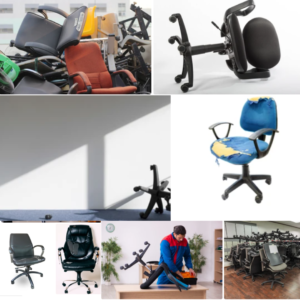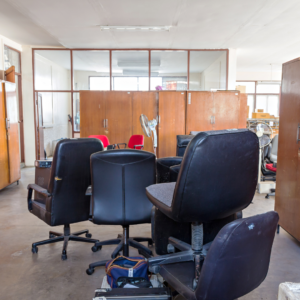How Do I Know If My Office Chair Is Safe? A Comprehensive Guide
In today’s world, where many of us spend countless hours seated at our desks, the importance of a safe and comfortable office chair cannot be overstated. But how do you know if your office chair is safe? This comprehensive guide will explore the various aspects of office chair safety, helping you make informed decisions about your seating arrangement and overall workplace well-being.
Understanding the Importance of Office Chair Safety
Before delving into the specifics of how to determine if your office chair is safe, it’s crucial to understand why this matter is so significant. A safe office chair not only provides comfort but also plays a vital role in preventing workplace injuries, promoting good posture, and enhancing overall productivity. Moreover, a safe chair contributes to long-term health by reducing the risk of musculoskeletal disorders and other health issues associated with prolonged sitting.
Key Factors to know if my Office Chair is safe
To answer the question “How do I know if my office chair is safe?” we need to examine several key factors. These include ergonomic design, stability, adjustability, materials used, and weight capacity. Let’s explore each of these aspects in detail.

1. Ergonomic Design: The Foundation of a Safe Office Chair
First and foremost, a safe office chair must have an ergonomic design. Ergonomics is the science of designing and arranging things people use so that they interact most efficiently and safely with their environment. When it comes to office chairs, ergonomic design focuses on supporting the natural curvature of the spine and promoting proper posture.
Key ergonomic features to look for include:
– Lumbar support: A good office chair should have adequate lower back support to maintain the natural curve of your spine.
– Seat depth and width: The seat should be wide enough to accommodate your hips comfortably and deep enough to support your thighs without putting pressure on the back of your knees.
– Backrest: A properly designed backrest should support the natural S-shape of your spine.
– Armrests: These should be adjustable to allow your arms to rest comfortably while keeping your shoulders relaxed.
How do I know if my office chair is safe in terms of ergonomics? Check if it has these features and if they can be adjusted to fit your body’s unique proportions.
2. Stability: Ensuring Your Chair Won’t Let You Down
Another crucial aspect of office chair safety is stability. An unstable chair can lead to accidents and injuries. To assess the stability of your office chair, consider the following:
– Base design: A five-point base provides better stability than a four-point base.
– Casters: High-quality casters should roll smoothly and be appropriate for your floor type (carpeted or hard surface).
– Weight distribution: The chair should feel balanced and not tip over easily when you lean in different directions.
Additionally, check for any wobbling or unusual noises when you sit in the chair or move around. These could be signs of instability or wear and tear that compromise safety.
3. Adjustability: Customizing Your Chair for Optimal Safety
A safe office chair should be highly adjustable to accommodate different body types and work styles. The ability to adjust various components of your chair allows you to create a personalized ergonomic setup that promotes safety and comfort.
Key adjustable features include:
– Seat height: You should be able to adjust the seat height so that your feet rest flat on the floor and your thighs are parallel to the ground.
– Backrest tilt: The ability to adjust the angle of the backrest helps maintain proper posture throughout the day.
– Armrest height and width: Adjustable armrests allow you to support your arms comfortably while typing or using a mouse.
– Seat depth: Some chairs offer adjustable seat depth, which is particularly useful for taller or shorter individuals.
When considering how do I know if my office chair is safe, assess whether it offers these adjustability options and if they’re easy to use.
4. Materials and Construction: The Building Blocks to know if office chair is safe

The materials used in your office chair play a significant role in its safety and durability. High-quality materials not only ensure longevity but also contribute to the overall safety of the chair.
Consider the following aspects:
– Frame material: Look for sturdy materials like steel or high-grade aluminum for the chair’s frame.
– Upholstery: Choose breathable, durable fabrics that can withstand daily use without wearing out quickly.
– Foam density: The seat cushion should have an appropriate foam density to provide comfort and support without bottoming out.
– Chemical safety: Ensure that the materials used in your chair are free from harmful chemicals or off-gassing substances.
Furthermore, examine the overall construction of the chair. Are the components securely fastened? Do you notice any loose parts or weak points? A well-constructed chair is essential for long-term safety and durability.
5. Weight Capacity: Ensuring Your Chair Can Support You Safely
Every office chair has a specified weight capacity, and it’s crucial to choose one that can safely support your body weight. Using a chair that’s not rated for your weight can lead to premature wear and tear, instability, and potential accidents.
How do I know if my office chair is safe in terms of weight capacity? Check the manufacturer’s specifications or look for a label on the chair itself. Most standard office chairs have a weight capacity between 250 and 300 pounds, but some heavy-duty models can support up to 500 pounds or more.
6. Compliance with Safety Standards: A Mark of Quality and Safety
Another way to determine if your office chair is safe is to check if it complies with recognized safety standards. Look for certifications from organizations such as:
– BIFMA (Business and Institutional Furniture Manufacturers Association)
– ANSI (American National Standards Institute)
– EN (European Standards)
These certifications indicate that the chair has undergone rigorous testing for safety, durability, and performance. While not all safe chairs will necessarily have these certifications, they provide an additional layer of assurance.
Maintaining Your Office Chair for Long-Term Safety
Knowing how to determine if your office chair is safe is just the first step. To ensure long-term safety and performance, regular maintenance is essential. Here are some tips to keep your chair in top condition:
– Clean regularly: Vacuum or wipe down your chair regularly to prevent dirt and debris from accumulating and potentially damaging components.
– Tighten loose parts: Periodically check for and tighten any loose screws or bolts.
– Lubricate moving parts: Apply lubricant to moving parts like casters and height adjustment mechanisms to keep them functioning smoothly.
– Replace worn components: If you notice worn-out casters, torn upholstery, or damaged armrests, replace them promptly to maintain safety.
– Follow manufacturer guidelines: Adhere to the manufacturer’s care and maintenance instructions for your specific chair model.
By maintaining your chair properly, you can extend its lifespan and ensure it remains safe for years to come.
Signs That Your Office Chair May Not Be Safe

Now that we’ve covered the key aspects of a safe office chair, let’s discuss some red flags that might indicate your chair is no longer safe or suitable for use:
1. Visible damage: Cracks in the frame, torn upholstery, or broken components are clear signs that your chair’s safety may be compromised.
2. Instability: If your chair wobbles, tips easily, or feels unstable when you sit in it, it’s time to reassess its safety.
3. Lack of adjustability: A chair that doesn’t allow you to adjust key components to fit your body properly can lead to discomfort and potential health issues over time.
4. Worn-out padding: If the seat cushion has flattened or lost its support, it may no longer provide adequate comfort and ergonomic benefits.
5. Unusual noises: Squeaking, creaking, or other strange sounds when you move in the chair could indicate structural issues.
6. Outdated design: If your chair is very old or lacks modern ergonomic features, it may not meet current safety standards.
If you notice any of these signs, it’s crucial to address them promptly, either by repairing the chair or considering a replacement.
Making an Informed Decision About Your Office Chair Safety

In conclusion, answering the question “How do I know if my office chair is safe?” involves considering multiple factors, including ergonomic design, stability, adjustability, materials, weight capacity, and compliance with safety standards. By carefully evaluating these aspects and maintaining your chair properly, you can ensure a safe and comfortable seating experience in your workspace.
Remember, investing in a safe and high-quality office chair is an investment in your health, productivity, and overall well-being. If you’re unsure about the safety of your current chair or are in the market for a new one, consider consulting with an ergonomics expert or reputable office furniture supplier. They can provide valuable insights and recommendations tailored to your specific needs and work environment.
Ultimately, a safe office chair should support your body comfortably, promote good posture, and withstand the rigors of daily use without compromising your safety. By staying informed and proactive about your seating choices, you can create a healthier, more comfortable, and more productive work environment for yourself.
